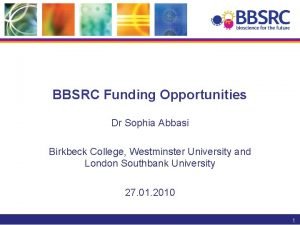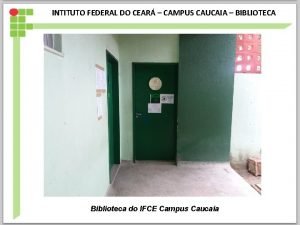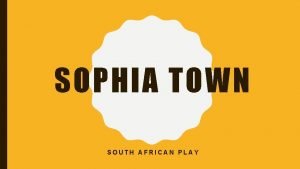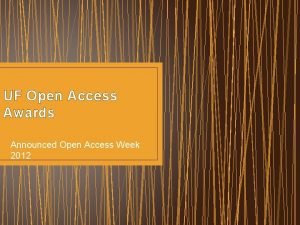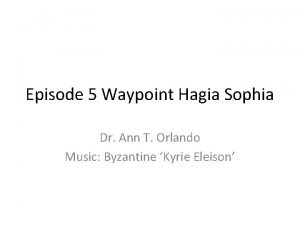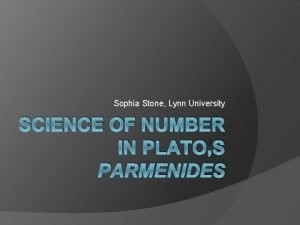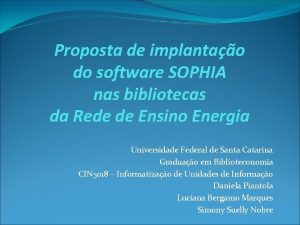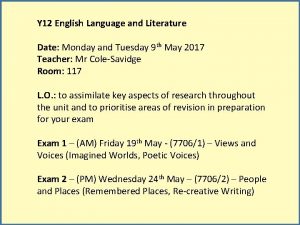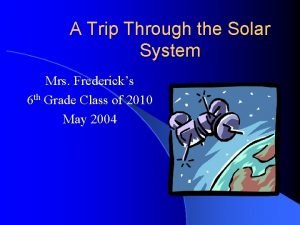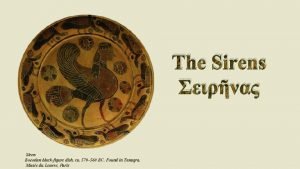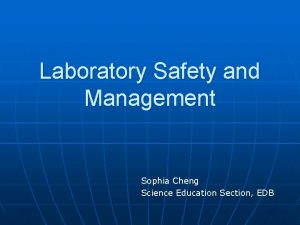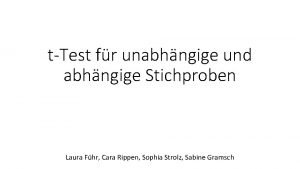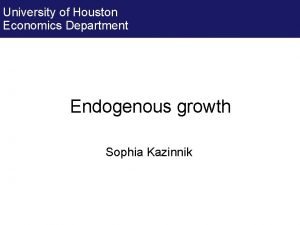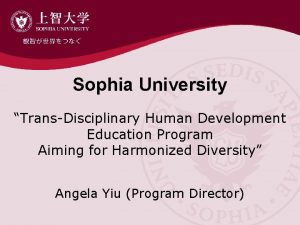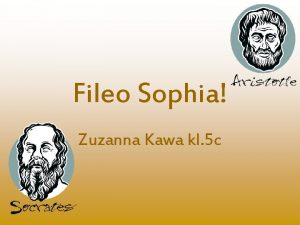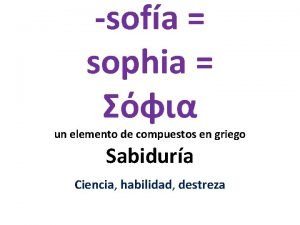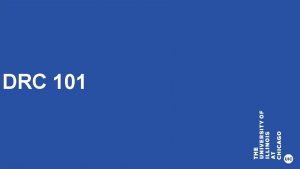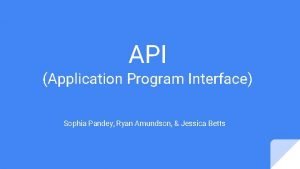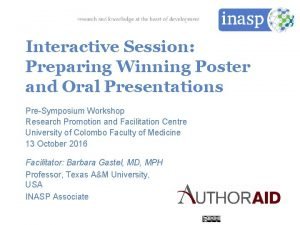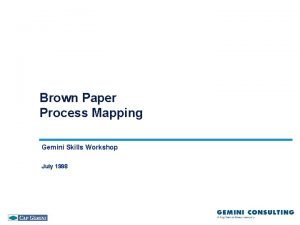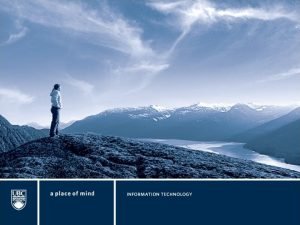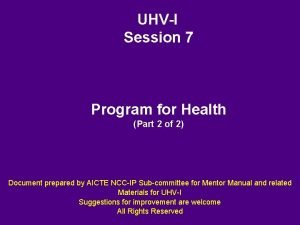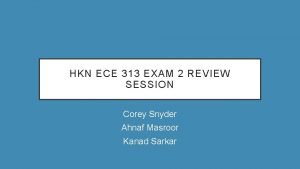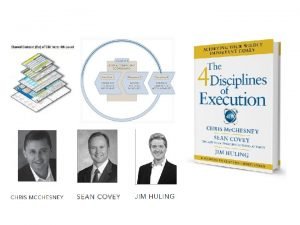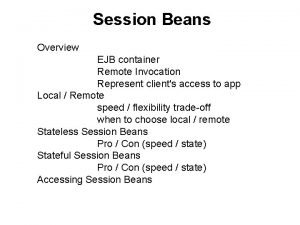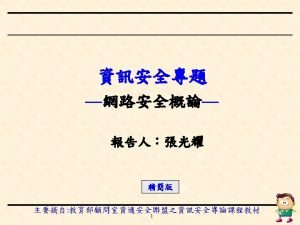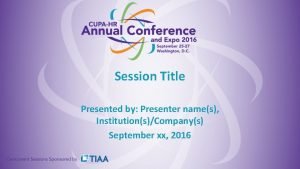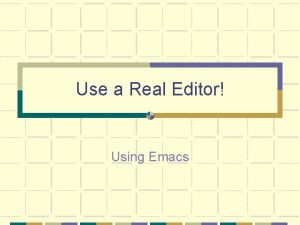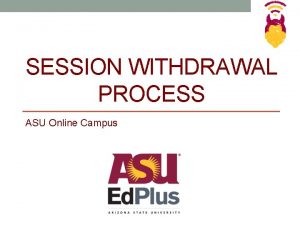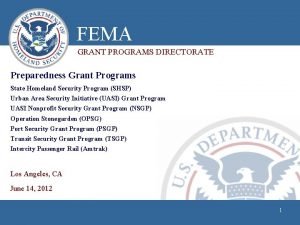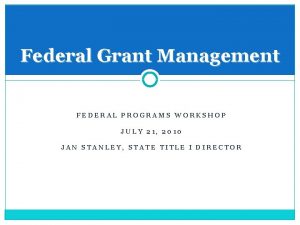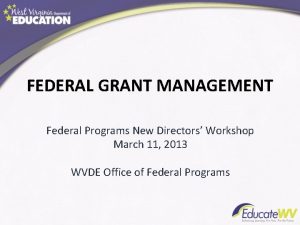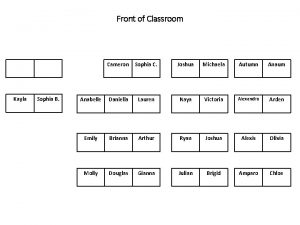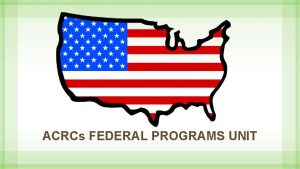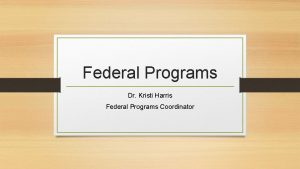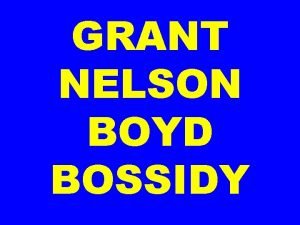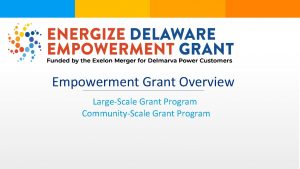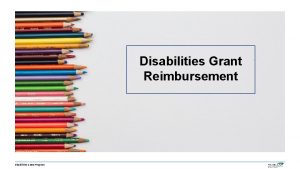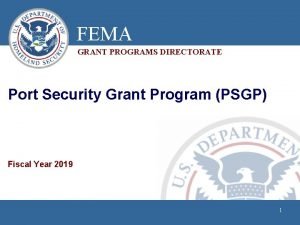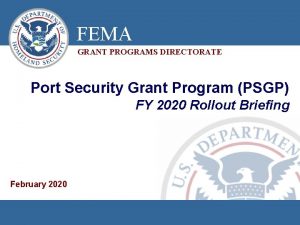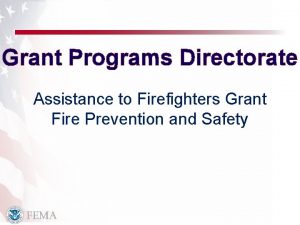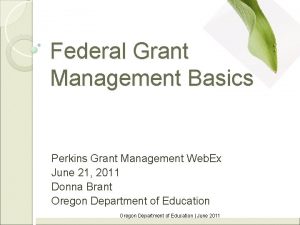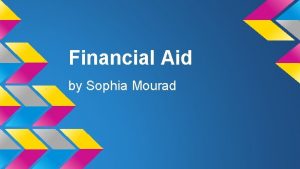Session 10 Requirements for Federal Grant Programs Sophia






































































































































- Slides: 134

Session 10 Requirements for Federal Grant Programs Sophia Mc. Ardle Carney Mc. Cullough Fred Sellers Office of Postsecondary Education Revised November 20, 2007

Agenda • • Legislation Pell/ACG/NSG Payment Calculations 2006 -2007 Negotiated Rulemaking ACG and National SMART Grant Final Regulations – Academic Year Progression – Grade Point Average (GPA) – Prior Enrollment – Successful Completion: Rigorous Secondary Programs – Recognition of Rigorous Secondary Programs – Determination of Eligible Majors – Documenting Eligible Majors 2

First Year Implementation Outcomes

Nationally ACG: • $233, 038, 410 awarded to 299, 089 students National SMART Grants: • $195, 544, 735 awarded to 60, 976 students 4

ACG: Top Five Institutions 1. Pennsylvania State University (4, 128) 2. University of California – Davis (1, 926) 3. University of Texas – Austin (1, 718) 4. University of California – Los Angeles (1, 686) 5. Ohio State University (1, 620) 5

National SMART Grants: Top Five Institutions 1. Brigham Young University (1, 584) 2. University of Phoenix (1, 326) 3. University of California – San Diego (921) 4. De. Vry University (789) 5. Pennsylvania State University (715) 6

Top National SMART Grant Majors 1. Biological and Biomedical Sciences 2. Engineering 3. Computer Science 7

Top Foreign Language Majors 1. Russian 2. Japanese 3. Chinese 8

“Best Practices” • Discuss the ACG and National SMART Grant Programs in State, local, and school-level outreach • Reach out to all potential eligibles, not just students who self-identify • Advocate for low-income students’ access to rigorous, college preparatory classes and pursuit of high-demand majors 9

Legislation 10

Legislation • Reauthorization – Senate passed July 24, 2007 – House • College Cost Reduction and Access Act (CCRAA) – Enacted September 27, 2007 11

Legislation: CCRAA – ACG and National SMART Grants • Makes no changes to the ACG and National SMART Grant Programs 12

Legislation: CCRAA – Pell • Eliminates Federal Pell Grant “tuition sensitivity” as of July 1, 2007 Effective: July 1, 2007 13

Legislation: CCRAA – Pell • Uses mandatory funds to increase the Pell Scheduled Award by – $ 490 for 2008 -09 and 2009 -10 – $ 690 for 2010 -11 and 2011 -12 – $ 1, 090 for 2012 -13 • Increases applicable to students eligible based on the maximum award set in an appropriations act Effective: 2008 -2009 award year 14

Legislation: CCRAA – Pell • For 2008 -09, if appropriations act sets a $4, 310 maximum award, the Scheduled Award would be: – Maximum $4, 800; and – Minimum $890. • Mandatory funds do not increase the number of eligible students. Effective: 2008 -2009 award year 15

Legislation: CCRAA – TEACH Grants • Establishes Teacher Education Assistance for College and Higher Education (TEACH) Grant Program • Is effective starting in 2008 -2009 Effective: 2008 -2009 award year 16

Legislation: CCRAA – TEACH Grants • Provides $4, 000 for each academic year • Has aggregate maximums – $16, 000 for first baccalaureate student or postbaccalaureate, nondegree student – $8, 000 for graduate student 17

Legislation: CCRAA – TEACH Grants • Student eligibility if a current enrolled student: – Is Title IV eligible; – Has 3. 25 GPA or statutory alternatives; and – Is completing, or plans to complete, coursework necessary to begin a career in teaching 18

Legislation: CCRAA – TEACH Grants • Student eligibility if a current or prospective teacher, seeking a graduate degree: • Is a teacher or retiree with expertise in a shortage area; or • Is or was a teacher with high quality alternative certification, e. g. , Teach for America 19

Legislation: CCRAA – TEACH Grants • Sign agreement to serve: - Must teach at Title I school - Must teach in specified areas (mathematics, science, foreign language, bilingual education, special education, or high-need field approved by the Secretary) • Treated as a Direct Unsub Stafford Loan if student does not teach 20

Pell/ACG/NSG Payment Calculations 21

Payment Calculations • Revisions in General Provisions final regulations package • Payment period definition • Programs eligible for Formula 1 • Payment calculations for Formulas 4 and, for Pell only, 5 A • Payment calculations the same for all three grant programs 22

Payment Calculations • Added educational programs eligible for Formula 1 • Is no change for traditional calendar programs currently eligible to use Formula 1, i. e. , programs with – two semesters or trimesters, or three quarters, in fall through spring, and – at least 12 hours as full-time for all terms in award year 23

Case Study: Currently Eligible for Formula 1 Fall Semester 16 weeks of i. t. Spring Semester 15 weeks of i. t. Summer 10 weeks of i. t. • Traditional semester-based academic calendar where full-time is defined as at least 12 semester hours in all terms. • Eligibility to use Formula 1 continues. 24

Payment Calculations • Adds programs eligible for Formula 1 where— – Any two semesters or trimesters, or three quarters is at least 30 weeks of i. t. ; – Program starts in cohorts of students, e. g. , monthly; – Program is offered exclusively in semesters, trimesters, or quarters; and – Student not enrolled in overlapping terms 25

Case Study: Final Rules Eligible for Formula 1 Cohort 1 Term A - 15 weeks Cohort 2 Term B - 15 weeks Term A - 15 weeks Cohort 3 Cohort 4 Term B - 15 weeks Term A - 15 weeks Term B - 15 weeks • The program consists of semesters. A new cohort of students start a new semester on the first workday of each month. 26

Payment Calculations • Revised Formula 4 payment calculations (Formula 5 A also) • No change in programs that use Formula 4: – Credit-hour programs without terms – Clock-hour programs • Lesser of two fractions based on the academic year measures 27

Payment Calculations Formula 4 Scheduled Award * the lesser of— Hours in the payment period Hours in the academic year OR *weeks in the payment period *weeks in the academic year *Weeks of instructional time 28

Case Study 1: Calculation Payment 28 quarter hours 28 weeks of instructional time • A nonterm undergraduate certificate program with scheduled classes • Academic calendar: 28 quarter hours over 28 weeks of instructional time • Academic year: 36 quarter hours and 30 weeks of instructional time 29

Case Study 1: Calculation 14 hours 14 weeks Payment 14 hours 14 weeks • Payment periods: 14 quarter hours and 14 weeks of instructional time • Formula 4 to calculate grant program payment for a payment period • Student: Pell Scheduled Award of $4, 000 30

Case Study 1: Calculation Payment 14 hours 14 weeks Step 1 • Payment for each payment period Scheduled Award = $4, 000 Step 2 Lesser of— 14 36 x $4, 000 = $1, 555 OR 14 30 x $4, 000 = $1, 866 31

Case Study 1: Calculation Payment 14 hours 14 weeks 1 st Pell disbursement 14 hours 14 weeks 2 nd Pell disbursement • The student receives two Pell disbursements that total $3, 110 out of a $4, 000 Scheduled Award. 32

Case Study 2: Calculation Payment 1200 clock hours 30 weeks of instructional time • Nonterm undergraduate certificate program with scheduled classes • Academic calendar: 1200 clock hours over 30 weeks of instructional time • Academic year: 900 clock hours and 26 weeks of instructional time 33

Case Study 2: Calculation 450 clock hours 13 weeks Payment 450 clock hours 13 weeks 300 clock hrs 4 weeks • Payment periods – 450 clock hours and 13 weeks of instructional time; and – 300 clock hours 4 weeks of instructional time 34

Case Study 2: Calculation 450 clock hours 13 weeks Payment 450 clock hours 13 weeks 300 clock hrs 4 weeks • Formula 4 to calculate grant program payment for a payment period • Student: Pell Scheduled Award of $1, 000 35

Case Study 2: Calculation 450 clock hours 13 weeks Payment 450 clock hours 13 weeks 300 clock hrs 4 weeks Step 1 • First and second payment periods Scheduled Award = $1, 000 Step 2 Lesser of— 450 900 x $1, 000 = $500 OR 13 26 x $1, 000 = $500 36

Case Study 2: Calculation 450 clock hours 13 weeks Payment 450 clock hours 13 weeks 300 clock hrs 4 weeks Step 1 • Third payment period Scheduled Award = $1, 000 Step 2 Lesser of— 300 900 x $1, 000 = $333. 33 OR 4 26 x $1, 000 = $153. 85 37

Case Study 2: Calculation 450 clock hours 13 weeks 1 st Pell disbursement Payment 450 clock hours 13 weeks 2 nd Pell disbursement 300 clock hrs 4 weeks 3 rd Pell disbursement • Student receives – $1, 000 for the first two payment periods – $0 for the third payment period; or, if the third payment period is in a new award year, $153. 85 (assuming same Scheduled Award). 38

2006 -2007 Negotiated Rulemaking 39

Negotiated Rulemaking • Federal Register notice - August 18, 2006 • 2008 -2009 and subsequent years • Regional hearings • Negotiating committee on ACGs and National SMART Grants • No consensus 40

Negotiated Rulemaking Issues • Prior enrollment • Rigorous secondary programs • GPA requirements • Eligible majors • Academic year progression • Mandatory participation • Certificate programs 41

Negotiated Rulemaking • NPRM: August 7, 2007 • Comments: due September 6, 2007 • 52 commenters • Final regulations: October 29, 2007 • Effective July 1, 2008 • Early implementation 42

ACG and National SMART Grant Final Regulations 43

Final Regulations Academic Year Progression 44

Academic Year Progression - Basics Award Eligibility Current § 691. 6(a), (b), and (c) • A student’s progression is based on the student’s attendance in all ACG and National SMART Grant eligible programs at all institutions. Final § 691. 6(a), (b), and (c) • A student’s progression is based on the student’s attendance in all ACG and National SMART Grant eligible programs only at the institution in which the student is currently enrolled. 45

Academic Year Progression - Basics Award Eligibility Current § 691. 6(a), (b), and (c) • A student may not receive more than two ACG Scheduled Awards and two National SMART Grant Scheduled Awards. Final § 691. 6(a), (b), and (c) • A student may not receive more than two ACG Scheduled Awards and two National SMART Grant Scheduled Awards during the student’s undergraduate education. 46

Academic Year Progression - Basics Exact Accounting (Final § 691. 6(e)(1)) • As with a student’s credit or clock hours, must determine a student’s progression in the weeks of instructional time of an academic year through an exact accounting of those weeks of instructional time • Are some exceptions • Is in line with current regulations, but are changes to the exceptions 47

Academic Year Progression - Basics Transfer Students (Final § 691. 6(d)(3)) • The institution to which the student transferred must count both: – The credit or clock hours earned by the student at prior institutions that are accepted for the student’s ACG or National SMART Grant eligible program, and – An estimated number of weeks of instructional time completed by the student. • Current requirement is a “may” in lieu of an exact accounting. 48

Academic Year Progression - Basics Transfer Students (Final § 691. 6(d)(3)) • To determine weeks of instructional time, must use specified formula: (hours accepted * weeks of i. t. in ac. yr) hours in ac. yr. • Subject to prohibition under § 691. 6(d)(2) for hours without weeks 49

Alternative Methods (Final § 691. 6(e), (f), (g), and (h)) • Three alternative methods for determining the weeks of instructional time that assure general compliance with the academic year progression requirements • Replacement of current § 691. 6(d) on treatment of summer terms • Also replacement to transitional guidance 50

Alternative Methods (Final § 691. 6(e), (f), (g), and (h)) • Only eligible programs that use Formula 1 or 2 to calculate payments (generally programs with traditional academic calendars) • Eligible programs that use Formulas 3 or 4: must always doing an exact accounting 51

Alternative Methods (Final § 691. 6(e), (f), (g), and (h)) • Terms-attended: count weeks of instructional time based on the number of terms the student has attended • Credits-earned: attribute weeks of instructional time to the credit hours earned by the student • Grade-level: use the student’s grade level as a basis for determining weeks of instructional time completed 52

Alternative Methods Exclusions (Final § 691. 6(g) and (h)) • Is applicable to the credits-earned and grade-level alternatives • In determining weeks of instructional time, must exclude consideration of hours subject to proposed § 691. 6(d)(2) 53

Alternative Methods Applicability (Final § 691. 6(e)(2)(ii)) • An alternative method of determining weeks of instructional time applies to all students enrolled in the eligible program. 54

Alternative Methods Exact Accounting (Final § 691. 6(e)(2)(iii)) • Upon a student’s request, an institution must provide an exact accounting of the student’s academic year progression in all eligible programs at that institution including any qualifying credit hours accepted on transfer in an ACG or National SMART Grant eligible program. • An institution may initiate an exact accounting for a student. 55

Alternative Methods Exact Accounting (Final § 691. 6(e)(3)) • After an exact accounting, an institution may not use any of the alternative methods in § 691. 6(f), (g), and (h) for determining that student’s academic year standing. 56

Hours without Weeks (Final § 691. 6(d)(2)) • No weeks of instructional time for hours in a student’s eligible program from: – Hours from AP and IB, testing out, life experience, or similar competency measures – Hours earned while not enrolled as a regular student in an ACG or National SMART Grant eligible program – Hours for coursework that is not at the postsecondary level, such as remedial coursework 57

Hours without Weeks (Final § 691. 6(d)(2)) • Prohibition on weeks of instructional time for credit or clock hours applies to: – Exact accounting; – Transfer credits; and – Credits-earned and grade-level alternatives. • While hours count towards the academic year progression, no weeks of instructional time are associated with these hours. 58

Hours without Weeks (Final § 691. 6(d)(2)(ii)) • An institution must assign weeks of instructional time to determine National SMART Grant eligibility for periods in which a student was enrolled in an ACG eligible program prior to declaring, or certifying his or her intent to declare, a National SMART Grant eligible major. 59

See Appendix A for a full-page view. 60

Final Regulations Grade Point Average 61

GPA: Numeric Equivalent Current Final § 691. 15(b)(1)(iii)(D) and (c)(3) • Have a GPA of at least 3. 0 on a 4. 0 scale, or the equivalent numeric equivalent • Does not mean institution can determine its own equivalency of a grading scale or simply use an equivalent measure 62

GPA: Numeric Equivalent (Final § 691. 15(g)) • If using alternatives to standard numeric grading, institutions must develop and apply an academically defensible equivalency policy. • Equivalency policy must be: – In writing; – Available to students upon request; and – Consistent with an institution’s other standards – academic and Title IV 63

GPA: Numeric Equivalent (Final § 691. 15(g)) • The policy must include clear differentiations of student performance to support a determination of performance at a level commensurate with at least a 3. 0 GPA on a 4. 0 scale 64

GPA: ACG – Transfers Current § 691. 15(d)(1) • For student who completed 1 st academic year in ACG eligible program at prior institution(s), institution to which the student transfers must calculate GPA using grades for courses accepted from any prior institution toward student’s ACGeligible program. Final § 691. 15(f)(1)(i) • For a student who transfers hours of at least one academic year but less than two, institution to which the student transfers must calculate GPA using grades for courses accepted from any prior institution toward student’s ACG-eligible program. 65

GPA: ACG - Transfers Current § 691. 15(d)(1) • For a student who completes first academic year after transferring, institution uses its own policy on how transfer credits are counted to determine whether grades for transfer credits are included in GPA at school to which student transferred. Final § 691. 15(f)(1)(i) • For a student who transfers in hours comprising less than one academic year, the institution uses grades for all coursework accepted by the current institution into the eligible program and grades for coursework earned at the current institution. 66

GPA: National SMART Grant Transfers Current § 691. 15(d) • For 1 st payment period must use student’s grades for courses accepted into the student’s National SMART Grant eligible program • If no credits accepted, must consider student ineligible for 1 st payment period Final § 691. 15(f)(2) • Use one of two methods: – Method # 1: transfer grades not incorporated – Method # 2: transfer grades incorporated 67

GPA: National SMART Grant Transfers (Final § 691. 15(f)(2)(i)) Method 1 – GPA • For 1 st payment period, use grades earned in courses accepted into National SMART Grant eligible program if academic policy does not incorporate grades from courses accepted • For subsequent payment periods, use institutional policy 68

GPA: National SMART Grant Transfers (Final § 691. 15(f)(2)(ii)) Method 2 – GPA • For 1 st payment period, use grades earned in courses accepted into National SMART Grant eligible program if academic policy incorporates grades from courses accepted • For subsequent payment periods, use institutional policy that includes grades for transfer courses 69

Final Regulations Prior Enrollment 70

Prior Enrollment: 1 st Year ACG Current Final § 691. 15(b)(1)(ii)(B) § 691. 15(b)(1)(ii)(C) • While in high school – Is not eligible if enrolled as a “regular student” in an ACG eligible program an ACG eligible while being at or program below the age of compulsory school – May be eligible if attendance not enrolled as a “regular student” in – May be eligible if not ACG eligible enrolled as a “regular program student” in ACG eligible program 71

Final Regulations SUCCESSFUL COMPLETION OF A RIGOROUS SECONDARY SCHOOL PROGRAM OF STUDY 72

Successful Completion of a Rigorous Program: High School Diploma Current Final § 691. 15(b)(1)(ii)(A) § 691. 15(b)(1)(iii)(A) • A student must • In addition to completing a complete a rigorous program, a program using student must receive a documentation from the high school diploma or, for appropriate cognizant a home-schooled student, authority provided by may receive certification of that authority or by the completion of a secondary student. education provided by the student’s parent or guardian. 73

Successful Completion of a Rigorous Program: Documentation Current § 691. 15(b)(2)(i) • Must document a student’s successful completion of a rigorous program using documentation from the appropriate cognizant authority provided by that authority or by the student Final § 691. 15(b)(2)(i) • Must document a student’s successful completion of a rigorous program and receipt of a high school diploma or certification of completing homeschooling 74

Successful Completion of a Rigorous Program: Cognizant Authority • Cognizant authority includes but is not limited to: – An LEA – An SEA or other State agency – A public or private high school – A testing organization such as the College Board or State agency – Parent if student is home-schooled 75

Successful Completion of a Rigorous Program: Self-certification (Final § 691. 15(b)(5)(i)) • Institution must attempt to document a student’s successful completion of a rigorous secondary school program of study in the case of any student who – Self-certifies on the FAFSA; or – Otherwise self-identifies to the institution. 76

Successful Completion of a Rigorous Program: Self-certification (Final § 691. 15(b)(5)(ii)) • If a student does not self-certify completion of a rigorous program on the FAFSA or otherwise, the institution is not required to determine the student’s ACG eligibility, notwithstanding 34 CFR 668. 16(f). 77

Final Regulations RIGOROUS SECONDARY SCHOOL PROGRAM OF STUDY 78

Recognition of a Rigorous Program: Currently Designated Programs • State-designated programs – State-submitted program – An advanced or honors program established by a State and in existence for the 2004 -2005 or 2005 -2006 school year – State Scholars Initiative 79

SSI States Arizona Arkansas Connecticut Indiana Kentucky Louisiana Maryland Massachusetts Michigan Mississippi Missouri Nebraska New Hampshire New Jersey New Mexico Oklahoma Rhode Island South Dakota Tennessee Utah Virginia Washington West Virginia Wyoming 80

Recognition of a Rigorous Program: Currently Designated Programs • Completion of at least 2 Advanced Placement (AP) courses with a passing test score of 3 for those courses or 2 International Baccalaureate (IB) courses with a passing test score of 4 for those courses • A set of courses as outlined in the regulations 81

Recognition of a Rigorous Program: Currently Designated Programs • The recognized set of courses consists of: – 4 years of English – 3 years of mathematics • Two of which must be algebra I and above – 3 years of science • Two of which must be one each of biology, chemistry, or physics – 3 years of social studies – 1 year of a language other than English 82

Recognition of a Rigorous Program: Currently Designated Programs • The Secretary publishes a list of rigorous programs of study that she recognizes: – For students who graduated in 2005 and 2006: http: //www. ed. gov/admins/finaid/about/acsmart/state-programs 06. html – For students who graduated in 2007: http: //www. ed. gov/admins/finaid/about/acsmart/2007/state-programs-07. html 83

Recognition of a Rigorous Program: Multi-year Recognition Current § 691. 16 • The Secretary recognizes at least one rigorous secondary school program of study established by an SEA or LEA in each State. Final § 691. 16(b)(2) • SEAs and LEAs to may request recognition of rigorous secondary school programs of study for school years beyond the immediate next school year. 84

Recognition of a Rigorous Program: State Advanced and Honors Programs Current § 691. 16 • The Secretary also recognizes additional secondary school programs of study as rigorous, including certain advanced and honors programs established by States and in existence for the 2004 -2005 or 20052006 school year. Final § 691. 16(d)(1) • The Secretary continues recognition of advanced or honors secondary school programs of study for school years subsequent to the 2005 -2006 school year. 85

Final Regulations ELIGIBLE MAJORS 86

Determination of Eligible Majors: Process Current § 691. 17(a) • For each award year, the Secretary identifies eligible majors in the physical, life, or computer sciences; mathematics; technology; engineering; and critical foreign languages. Final § 691. 17(d) and § 691. 2(d) • A process is added for institutions to request that additional majors be added to the list of eligible majors for National SMART Grants. • The proposed additional eligible major would be identified by its Classification of Instructional Programs (CIP) code. 87

Determination of Eligible Majors: Process • Requests for designation of an additional eligible major must include: – The CIP code and program title of the additional major – The reason or reasons the institution believes the additional major should be considered – Documentation showing that the institution has actually awarded or plans to award a bachelor’s degree in the requested major 88

Determination of Eligible Majors: CIP Code Definition (Final § 691. 17(d) and § 691. 2(d)) • Adds a definition of CIP code as it pertains to the National SMART Grant Program to current § 691. 2(d) – A taxonomy of instructional program classifications and descriptions developed by the U. S. Department of Education’s National Center for Education Statistics 89

Determination of Eligible Majors: Dear Colleague Letter GEN-07 -06 • Published September 2007 • Provides an updated list of eligible majors for the 2007 -2008 award year • Does not remove any eligible majors; only adds new eligible majors 90

Determination of Eligible Majors: Dear Colleague Letter GEN-07 -06 Additional fields of study: • • • 01. 1001 Food Science 01. 1002 Food Technology and Processing 03. 0104 Environmental Science 03. 0301 Fishing and Fisheries Science and Management 03. 0502 Forest Sciences and Biology 03. 0509 Wood Science and Wood Products/Pulp and Paper Technology 03. 0601 Wildlife and Wildlands Science and Management 30. 1001 Biopsychology 30. 1901 Nutrition Sciences 42. 1101 Physiological Psychology/Psychobiology 91

Determination of Eligible Majors: Dear Colleague Letter GEN-07 -06 92

Documenting Major Current § 691. 15(c)(2) • A student must formally declare an eligible major in accordance with institutional academic requirements. Final § 691. 15(d)(1) § 691. 15(e) • The final regulations clarify how an institution must document: – a student’s eligible major; and – progress in the eligible program and major. 93

Documenting Major Final Current § 691. 15(d)(1) § 691. 15(c)(2) § 691. 15(e) • A student must formally declare an • An institution must maintain documentation of: eligible major in – the declared major, or accordance with institutional academic – in the case of a student’s intent to declare a major, a requirements. written declaration of intent provided by the student timely enough for the institution to determine that it still correctly reflects the student’s stated intent. 94

Documenting Major Current § 691. 15(c)(2) • If institutional procedures do not allow formal major declaration in time to qualify for a National SMART Grant, a student must demonstrate intent to declare an eligible major as documented by the institution and formally declare as soon he or she is able. Final § 691. 15(d)(1) § 691. 15(e) • The final regulations require written documentation showing that the student is completing coursework at an appropriate pace in the student’s declared eligible major or intended eligible major. 95

Documenting Major DCL GEN-07 -07 Current § 691. 15(c)(2) (ii) • Student must enroll in courses necessary both to complete the degree program and fulfill the eligible major requirements. GEN-07 -07 October 9, 2007 • Student must be enrolled in at least one course that meets the specific requirements of the student’s National SMART Grant-eligible major to receive a National SMART Grant for the payment period. 96

Documenting Major DCL GEN-07 -07 • Implementation – The remainder of the 2007 -2008 award year except through the fall payment period for • Students already packaged and disbursed; or • Students already packaged – 2008 -2009 award year and beyond • No changes required for the 20062007 award year 97

Contact Information We appreciate your feedback and comments. We can be reached at: Sophia Mc. Ardle • Phone: 202 219 -7078 • Email: sophia. mcardle@ed. gov Carney Mc. Cullough • Phone: 202 502 -7639 • Email: carney. mccullough@ed. gov Fred Sellers • Phone: 202 502 -7502 • Email: fred. sellers@ed. gov Fax: 202 502 -7874 98

Appendix A 99

100

Appendix B 101


103

104

105

106

107

108

109

110

111

112

113

114

115

116

117

118

119

120

121

122

123

124

125

126

127

128

129

130

131

132

133

134
 Overview of software engineering
Overview of software engineering Birkbeck university
Birkbeck university Sophia biblioteca ifce
Sophia biblioteca ifce Benedetto gui
Benedetto gui Sophia de mello breyner biografia
Sophia de mello breyner biografia Nadace sophia
Nadace sophia Sophiatown play characters
Sophiatown play characters Spirit of truth sophia institute
Spirit of truth sophia institute Jay ritter uf
Jay ritter uf Sophia andreas
Sophia andreas Philia and sophia
Philia and sophia Sophia brelvi
Sophia brelvi Jerome believes that his 4-year-old grandson
Jerome believes that his 4-year-old grandson Sophia hinz
Sophia hinz Ryan amundson
Ryan amundson Dr sophia hu
Dr sophia hu Miss sophia huck finn
Miss sophia huck finn Sofia stone biografia
Sofia stone biografia Sophia ufpr
Sophia ufpr Sophia gardens events
Sophia gardens events Sophia software
Sophia software Hagia sophia
Hagia sophia Okno
Okno Gnhq merchants
Gnhq merchants Philos e sophia que significam
Philos e sophia que significam Hagia sophia height
Hagia sophia height Sophia schliemann
Sophia schliemann Venus hammink
Venus hammink Sophia ananiadou
Sophia ananiadou A sea spell painting
A sea spell painting Santa sophia college
Santa sophia college Sophia cheng accident
Sophia cheng accident Sophia dilbert
Sophia dilbert Abhängiger t test
Abhängiger t test Nadace sophia
Nadace sophia Sophia pellitteri
Sophia pellitteri Patric dahse
Patric dahse Sophia kazinnik
Sophia kazinnik Holy sophia university
Holy sophia university Fileo sophia
Fileo sophia Filosofia philos sophia
Filosofia philos sophia Sophia duval
Sophia duval Sophia en griego
Sophia en griego Uic drc
Uic drc Sophia pandey
Sophia pandey Linda evangelista face shape
Linda evangelista face shape Sophia shao
Sophia shao Elektronik för barn
Elektronik för barn Kassaregister ideell förening
Kassaregister ideell förening Borra hål för knoppar
Borra hål för knoppar Smärtskolan kunskap för livet
Smärtskolan kunskap för livet Bris för vuxna
Bris för vuxna Bra mat för unga idrottare
Bra mat för unga idrottare Frgar
Frgar Teckenspråk minoritetsspråk argument
Teckenspråk minoritetsspråk argument Datorkunskap för nybörjare
Datorkunskap för nybörjare Delegerande ledarskap
Delegerande ledarskap Ellika andolf
Ellika andolf Ekologiskt fotavtryck
Ekologiskt fotavtryck Steg för steg rita
Steg för steg rita Toppslätskivling effekt
Toppslätskivling effekt Redogör för vad psykologi är
Redogör för vad psykologi är Bästa kameran för astrofoto
Bästa kameran för astrofoto Geometri för barn
Geometri för barn Publik sektor
Publik sektor Texter om sommaren
Texter om sommaren Ledarskapsteorier
Ledarskapsteorier Klädsel i rom
Klädsel i rom Tidbok för yrkesförare
Tidbok för yrkesförare Orubbliga rättigheter
Orubbliga rättigheter Kontinuitetshantering i praktiken
Kontinuitetshantering i praktiken Ministerstyre för och nackdelar
Ministerstyre för och nackdelar Big brother rösta
Big brother rösta Sju principer för tillitsbaserad styrning
Sju principer för tillitsbaserad styrning Bat mitza
Bat mitza Romarriket tidslinje
Romarriket tidslinje Tack för att ni lyssnade bild
Tack för att ni lyssnade bild Nyckelkompetenser för livslångt lärande
Nyckelkompetenser för livslångt lärande Modell för handledningsprocess
Modell för handledningsprocess Varför kallas perioden 1918-1939 för mellankrigstiden
Varför kallas perioden 1918-1939 för mellankrigstiden Vad är verksamhetsanalys
Vad är verksamhetsanalys Stål för stötfångarsystem
Stål för stötfångarsystem Texter för hinduer tantra
Texter för hinduer tantra Cks
Cks Verktyg för automatisering av utbetalningar
Verktyg för automatisering av utbetalningar Kolopskopi
Kolopskopi Urban torhamn
Urban torhamn Inköpsprocessen steg för steg
Inköpsprocessen steg för steg Strategi för svensk viltförvaltning
Strategi för svensk viltförvaltning Sura för anatom
Sura för anatom Typiska drag för en novell
Typiska drag för en novell Formel gruplar
Formel gruplar Tack för att ni har lyssnat
Tack för att ni har lyssnat Läkarutlåtande för livränta
Läkarutlåtande för livränta Klassificeringsstruktur för kommunala verksamheter
Klassificeringsstruktur för kommunala verksamheter Tack för att ni lyssnade
Tack för att ni lyssnade Att skriva en debattartikel
Att skriva en debattartikel Påbyggnader för flakfordon
Påbyggnader för flakfordon Egg för emanuel
Egg för emanuel En lathund för arbete med kontinuitetshantering
En lathund för arbete med kontinuitetshantering Atmosfr
Atmosfr Meios steg för steg
Meios steg för steg Programskede byggprocessen
Programskede byggprocessen Rutin för avvikelsehantering
Rutin för avvikelsehantering Myndigheten för delaktighet
Myndigheten för delaktighet Presentera för publik crossboss
Presentera för publik crossboss Rbk-mätning
Rbk-mätning Förklara densitet för barn
Förklara densitet för barn Kung som dog 1611
Kung som dog 1611 Nationell inriktning för artificiell intelligens
Nationell inriktning för artificiell intelligens Tack för att ni har lyssnat
Tack för att ni har lyssnat Tobinskatten för och nackdelar
Tobinskatten för och nackdelar Hur ser ett referat ut
Hur ser ett referat ut Luftstrupen för medicinare
Luftstrupen för medicinare Karttecken kraftledning
Karttecken kraftledning Kraft per area
Kraft per area Avrunda decimaltal
Avrunda decimaltal Interactive session poster
Interactive session poster Brown paper exercise process mapping
Brown paper exercise process mapping Partnering session
Partnering session Nexthink user session monitoring
Nexthink user session monitoring Pdp staff
Pdp staff Uhv session
Uhv session Hkn review session
Hkn review session Compelling scoreboard
Compelling scoreboard Coaching session agenda
Coaching session agenda Stateful session bean life cycle
Stateful session bean life cycle Bgp session culling
Bgp session culling Network osi
Network osi Session title examples
Session title examples Microsoft architecture design session
Microsoft architecture design session Nexthink user session monitoring
Nexthink user session monitoring Awareness session invitation
Awareness session invitation Emacs session
Emacs session Asu complete session withdrawal
Asu complete session withdrawal

